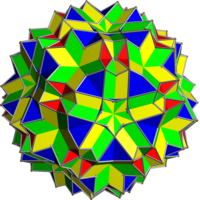| Compound of two great snub icosidodecahedra | |
|---|---|
 | |
| Type | Uniform compound |
| Index | UC70 |
| Polyhedra | 2 great snub icosidodecahedra |
| Faces | 40+120 triangles, 24 pentagrams |
| Edges | 300 |
| Vertices | 120 |
| Symmetry group | icosahedral (Ih) |
| Subgroup restricting to one constituent | chiral icosahedral (I) |
This uniform polyhedron compound is a composition of the 2 enantiomers of the great snub icosidodecahedron.